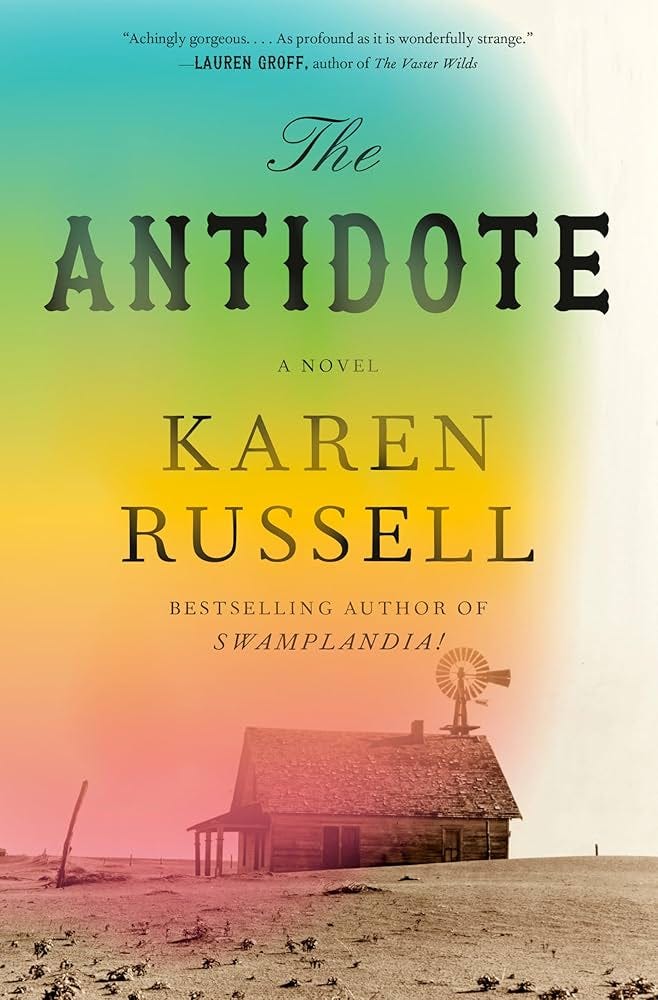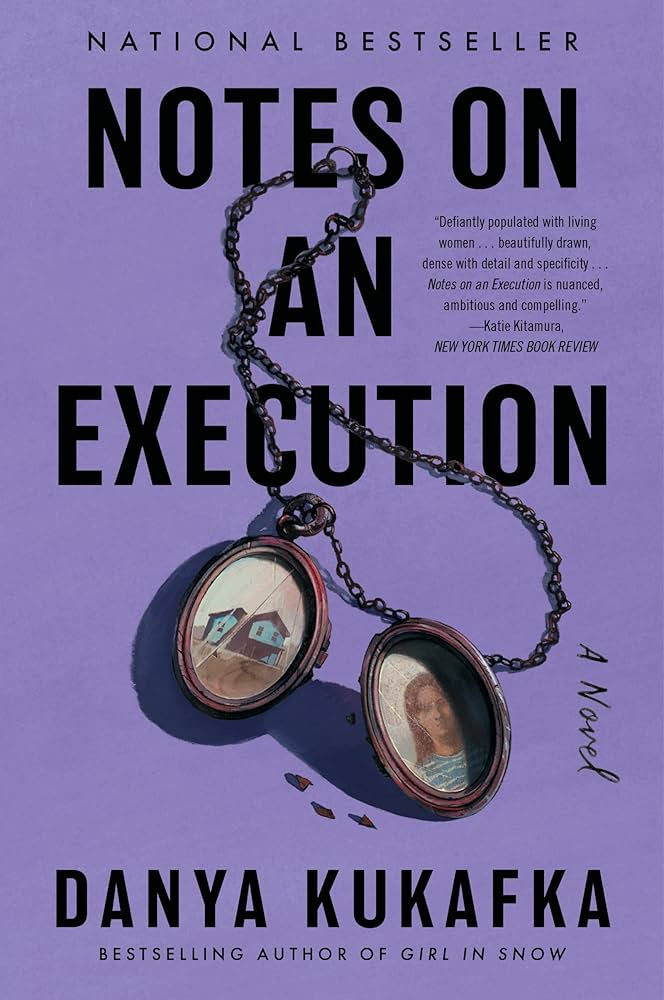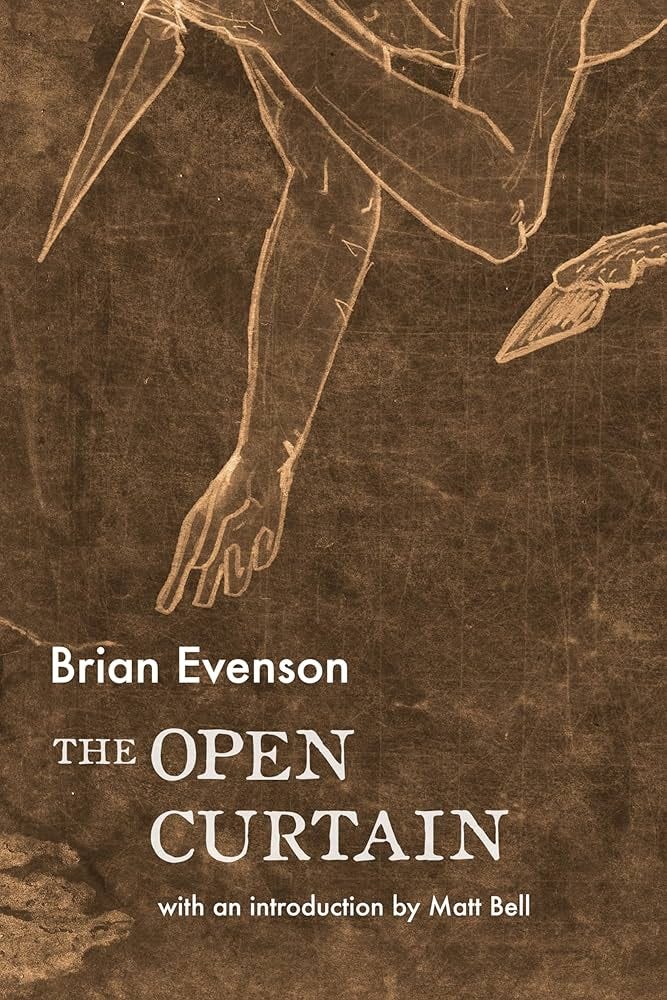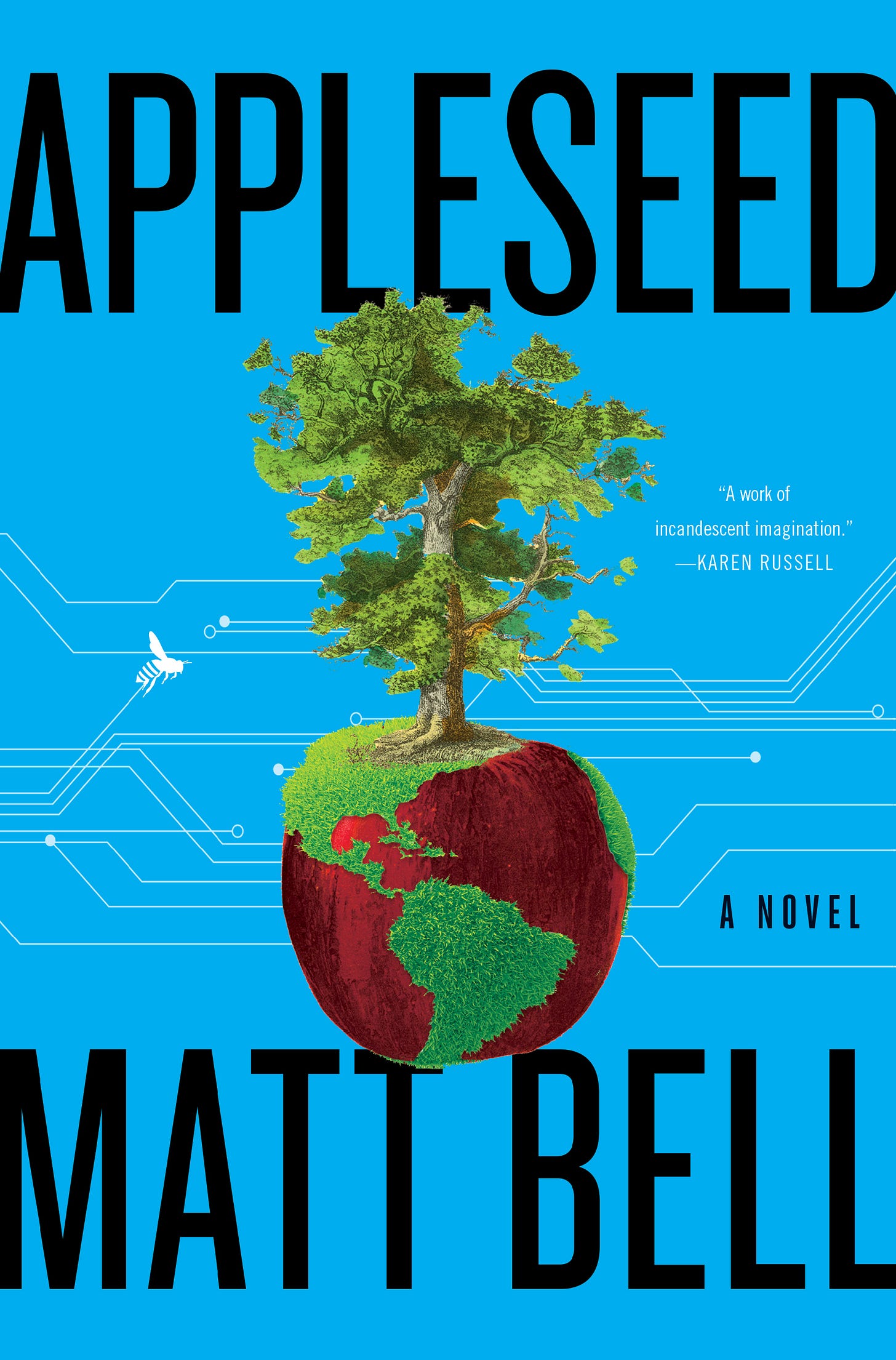#54: Putting Your Chapter Titles to Work
Karen Russell, Brian Evenson, Danya Kukafka, Chuck Palahniuk, Diane Williams
Hello friends! A few bits of news before this month’s craft essay: First, I’ve got a new short story titled “Home Sweet NewHome” in the journal Daedalus, for an issue themed “How Will We Talk About the Past in the Future?” The issue includes new work by Jericho Brown, Anne Carson, Natalie Diaz, Madeline Syet, among others, plus my friend and colleague Leah Newsom, who contributed a fantastic story called “Horseplay” that I can’t recommend highly enough. (Leah also designed the logo for this newsletter!)
I’ll also be doing another quarterly Zoom craft lecture for paying subscribers, on September 9, 2025, at 7pm ET. Next week, I’ll send out a survey with a handful of potential topics to anyone who is currently a paid subscriber at that time, so that you can vote on which lecture you want this time out. If you’d like to be part of that vote and/or the lecture, all you have to do is upgrade to a paid subscription. Thanks again!
Putting Your Chapter Titles to Work
Every short story necessarily needs a title—even “Untitled” is a title—and generally we want that title to do as much work as it can. As Diane Williams said once, “The title is one’s first chance—Please listen to me! It’s a beckoning, the first opportunity to bewitch after I’ve written a story, done all this work. Here’s the opportunity to create more implication and latitude.” But what about chapters of novels? Do they need titles? And if so, what should they accomplish?
Many novels do not have chapter titles, of course. Some of those simply use numbers, and some forgo even that, preferring page breaks and white space to any kind of adornment. Even chapters aren’t strictly necessary. In one early draft, my novel In the House upon the Dirt Between the Lake and the Woods was a five-hundred page scroll of text without any subdivisions. I remember telling my agent that—after I’d already fixed it!—and watched him put his head down on the table. Perhaps not the most commercial choice! (That novel is now in numbered parts containing unmarked sections—and my editor Mark Doten was the one who figured out where to break the parts. Thankfully!)
If you do decide to include chapter titles, then you may try to get out of them all the that story titles can do, including creating anticipation, adding nuance to the material, or spotlighting some aspect of it. At the very least, they might indicate point of view or setting. But section headings in long works offer up other abilities too, including generating or extending suspense, showing changing relationships or character roles, or even accelerating or undoing the progress of the narrative. They’re also one of the ways an author can add a subtle meta-commentary, speaking to the reader outside of the main text, sometimes offering interpretations or suggestions that the characters can’t make.
Below, I’ll offer some examples from a handful of published novels (including one of mine), where I think the chapter titles are doing interesting work. Please note that to talk about the novels’ chaptering strategies, it’s occasionally necessary to talk about what’s happening in the plot as well. So if you haven’t read The Antidote by Karen Russell, The Open Curtain by Brian Evenson, Survivor by Chuck Palahniuk, Notes on an Execution by Danya Kukafka, or my novel Appleseed, just know that some elements might be spoiled here. That said, I’ve done my best to not discuss any more story than is necessary.
The Antidote: Tracking Character Roles and Relationships
Nearly every chapter of Karen Russell’s excellent new Dust Bowl novel Antidote is titled with its narrator’s name, and often (but not always) another phrase, usually describing a role or reputation. In the first act of the book—itself titled “The Collapse”—we get four different narrators: The Prairie Witch, Asphodel Oletsky, Harp Oletsky, and The Scarecrow. In this section, Harp is the only one of the characters with an additional role: he’s always listed as “The Dryland Farmer, Harp Oletsky.” But as the novel progresses, the chapter titles shift too: Asphodel, Harp’s niece and the basketball star of the local team The Dangers, finds herself taking on new roles as the book goes on, all of which are reflected in her chapter titles in the novel’s first two acts. In the table of contents, she is described variously, in this order (with multiple chapters lived under most of these headings):
Asphodel Oletsky
The Prairie Witch’s Apprentice, Asphodel Oletsky
The Player-Captain of the Dangers, Asphodel Oletsky
The Regional Champ, Asphodel Oletsky
Asphodel Oletsky
When Asphodel’s role changes, so do her headings; most other characters in Russell’s novel follow suite. Over the course of the book, the Prairie Witch becomes the Antidote becomes Antonina Rossi, her chapter titles showing a progression in her self-image, moving from the disparaging name others call her to the still-effaced way she thinks of herself to her actual name, a move that mirrors her change in status from an outsider to a member of the small community, a kind of found family made of the novel’s POV characters.
Curiously, after a certain point in the third act of the book, all the chapters become titled simply by character name, dropping the roles forever. I don’t know exactly why Russell made this choice—everything I’ve written about her chaptering is pure conjecture, including this—but on reflection it occurs to me that by this point in the book, the found family has been formed, and the characters know each other by name, not reputation or roles—and therefore so should we. The last character to switch to their name alone is Antonina Rossi, whose headings only switch after she completes telling Asphodel the story of how she became the Prairie Witch. Once she’s done so, she becomes Antonina not only to the others in her found family, but to the novel itself.
It’s worth noting that there are some exceptions to the general rules above: the novel’s prologue is a chapter titled “Deposit 69818060-1-77: Harp Oletsky’s First Memory,” which is written in the second person, used nowhere else in the novel at the same length; a later chapter—“Tomaz’s Oletsky’s Deposit’—is in the first, like most of the rest of the book. One section is narrated by a cat known, in its chapter title, as “The Cat.” And so on. But by and large, Russell’s approach to chapter titles serves to create a guide to the emotional journey of the novel’s characters, likely helping the attentive reader better follow the changing relationships they form and the roles they take on.
Notes on an Execution and Survivor: Centering a Clock to Build Suspense
Danya Kukafka’s fantastic crime novel Notes on an Execution begins on the day of the scheduled execution of a serial killer, Ansel Packer, with a chapter titled “12 Hours.” Immediately, we have a character, a question—will Packer’s execution happen as expected?—and a clock: in twelve hours, Packer will either be pardoned or have his sentence commuted or he will escape or he will be executed. The novel alternates between these hourly chapters— “10 Hours,” “8 Hours,” 6 and 4 and 1 hours and so on, then finally “18 Minutes,” then “0”. In between are chapters about three women in Ansel’s life, Hazel, Saffy, and Lavender, whose chapters are always tagged with the year they take place in, advancing through time: “Lavender: 1973,” “Hazel: 1990,” “Saffy: 1999,” and so on. In the novel’s final act, the women reach the present in three consecutive chapters—”Lavender: Now,” “Saffy: Now,” “Hazel, Now”—during the last eighteen minutes of Ansel’s countdown. The chapter titles communicate a lot of information—who this chapter is about and when is it happening—but they also keep the novel’s clock at the forefront of the reader’s mind until the past at last collides with the present.
Chuck Palahniuk’s Survivor utilizes a similar trick. Palahniuk doesn’t use chapter titles, only numbers, but his first chapter is 47 and his first page is numbered 289—and then both numbers count down from there. Protagonist Tender Branson dictates his tale into the flight recorder of a plane due to crash in, well, 47 chapters and 289 pages. The story itself roams back and forth through Branson’s life, but the ever-dropping chapter/page numbers never let you forget that his time is limited. Almost all good stories get some of their drama from a clock exerting pressure on the action or the telling of it, and Palahniuk’s chapter numbering never lets you forget that this particular story is destined for a bad end.
The Open Curtain: Using Chapter Titles to Refuse Linear Progress
Brian Evenson’s novel The Open Curtain is an all-time favorite of mine, one I’m in the middle of rereading for the first time in a decade. Like many of Evenson’s fictions, The Open Curtain follows a character—in this case, Rudd, a Mormon teenager who’s recently discovered he has a half-brother—as they encounter something that destabilizes their sense of self and psychological well-being. Rudd and his half-brother Lael (who may or may not exist) become obsessed with a 1902 murder committed by William Hooper Young, the grandson of Brigham Young, and with the ritual of “blood sacrifice”; as the novel progresses, Rudd begins to lose chunks of time and to question his own identity, almost certainly committing violent crimes he can’t or won’t remember. The novel is built out of three novellas, themselves with parallel titles: “Rudd, Parsed,” “Lyndi, Adrift,” and “Hooper, Amuck”. Each novella is subdivided into numbered chapters, which for most of the book progress normally. But at the begging of “Hooper, Amuck,” the chapters numbers briefly stutter, repeating the number 1 for three sections, as well as the first lines of each chapter.
Chapter 1 begins with Hooper’s confusion: “It took him a long moment to understand where he was. At first there was only a gray space, featureless, unlit, as tight upon and around him as a coffin, which slowly began to congeal, if congeal was the right word, into something else.” And it ends with the man Elling—Hooper’s supposed accomplice in the murder he was convicted of—saying, “We’ll start again.”
The next chapter—also Chapter 1—begins, “It took him a moment to understand where he was. At first there was only a gray space, featureless, unlit, but it opened itself up, began to acquire variance, contour. A room, then.” A few paragraphs later, Hooper says, “He had the vague impression that all this had happened before.” Once again, the chapter ends with Elling restarting the cycle: “Focus, Hooper, focus. Look, We’ll leave you clues or something. Notes. Will that help? Third time’s the charm.”
A new chapter—Chapter 1 for the third time—begins: “For a moment he was not certain where he was. There was at first only a gray space, unlit, without features, closed in tight around him like a coffin…” Only now does the narrative properly progress, with Hooper using the clues offered in the second chapter 1 to exit the loop for the fourth chapter of his story, at last numbered Chapter 2.
It’s possible to read The Open Curtain without noticing that stuttering, resetting Chapter 1… but it’s a smart reward for attentive readers, and it mimics well what’s happening in the plot and in Rudd/Hooper’s psychology.
Appleseed: Helping a Book Know What Its Characters Can’t
In my novel Appleseed, there are three storylines, each with its own protagonist: Chapman, John, and C-432. Their names make up the bulk of the chapter titles in the novel, mostly (but not always) alternating in order. That’s simple enough! First and foremost, their chapter titles are merely indicating who the protagonist of each chapter as efficiently as possible, without asking the text itself to spend energy to do so. Beyond that, my chapter titles aim to accomplish a handful of other things:
A) The first time each character takes the stage, their chapter also has a subtitle, so that they appear as such:
Chapman: The Invincible Earth
John: The Manifest Earth
C-432: The Earth Reset
These subtitles never appear again, nor do they appear in the text in any other way. But for me, writing the novel, they were the titles of the three storylines that weave together to make Appleseed, almost as if they were each their own book. They’re also clues to the status of the world in each of the storylines, giving readers information that the characters couldn’t or wouldn’t express themselves. For instance, Chapman, who begins his story in the late 18th century, doesn’t believe in extinction or climate change or the exhaustibility of natural resources in the way that we do: the earth in his mind is literally invincible, or so many Americans believed in that era, including mammoth-obsessed Thomas Jefferson, who believed the animals must still be alive somewhere in America. “Such is the economy of nature,” Jefferson wrote in 1784, “that no instance can be produced of her having permitted any one race of her animals to become extinct; or her having formed any link in her great work so weak as to be broken.” My Chapman lives in the same “invincible” word Jefferson does but couldn’t have Jefferson’s thought. I left it up to the chapter subtitle to suggest it.
John’s timeline is a worst-case climate scenario set in the late 21st century, where the effects of unchecked capitalism, extractive industries, and so on have been taken to their farthest extremes. Unlike Chapman, John knows what happened to his world—but the chapter title is still an efficient way to suggest the status to the reader, and (for me) to signal the continuation of Manifest Destiny and related philosophies from the settlers of my 18th century to the technocrats of my 21st.
C-432 doesn’t understand the world he lives in, a North America that’s became covered with glaciers again, after some kind of catastrophe that left C as the only living thing he knows about. His “Earth Reset” is just that: an attempt at a reboot, something that matches his own life as a frequently recycled and reprinted clone.
Toward the end of the first act, there’s a fourth “earth” that enters, again through a new character and a new chapter title: “The First Faun: The Mythic Earth” adds one more timeline to the book, just briefly, but by doing so I wanted to widen the scale of the book to include not just a linear timeline of 1000 years but also to connect to a history of myth and philosophy and Western civilization that goes farther back than the novel can depict.
B) The other exceptions to the above pattern of Chapman, John, and C are interruptions, bringing in other voices in the book’s third act: Eury Mirov, the novel’s prime antagonist, gives a speech in one; two clones—E-5 and John-X—give their own monologues in others. Appleseed proper is in the third person but all three of these interruptions are in the first person. The changing chapter titles again indicate who’s talking without taking up undue space in the text; presumably they also create a little jolt of excitement in a reader who’s already read hundreds of pages dominated by the three prime protagonists. Here at last, the chapter titles announce, is something different. It’s a good promise to make and deliver on from time to time.
C) Just once in the book, the chapter titles create a progression as well as indicating a change to a protagonist, somewhat like what the Russell headings do. In C-432’s second chapter, he suffers a mortal injury, so recycles himself, using his biomass to build a new version of himself. When his third chapter begins, he’s about to be reprinted into a new body, and so from here on out his titles change to C-433, indicates that he’s not exactly the same person he was. It’s a subtle bit of worldbuilding that nonetheless hopefully communicates something important to the reader. It’s never explained in the text how long C’s been alive or how many times he’s been reprinted, but the incremental change to his name (and chapter titles) offers a hint: 432 lives, as long or as short as those lives might be, is a pretty good clock.
What ideas a novel can contain is to some extent limited by the mind of its protagonist: what they notice, what they care about, what interests and obsessions and knowledges they have, their politics and philosophies. Trying to make characters mouthpieces for the author’s ideas (as opposed to the character’s) is a surefire way to end up with a pedantic, didactic novel. But a constant question I ask myself is: How can my novel be smarter than its characters? (Related: How can my novel be smarter than its writer?) The chapter title tactics I used—maybe especially the various “earths” that subtitle the first appearances of my protagonists—are one of the ways I’ve attempted to make my “smarter novel” happen, hopefully broadening the scope of the novel’s ideas and questions beyond the individual perspectives of my protagonists. Not every reader is going to notice these moments—maybe no reader has!—but it’s always important for me to make the attempt wherever I can.
The examples above obviously aren’t the only things chapter titles can do! But hopefully these models will help you think about what your own headings are doing to increase the reader’s pleasure or the depth of their experience. If you have other examples of interesting chapter title choices (or chaptering strategies in general), I’d love to hear about them in the comments.
Good luck with your writing this month! More soon, friends.
Thanks so much for reading! If you’re not already subscribed, please consider doing so by clicking the button below.
Matt Bell’s novel Appleseed (a New York Times Notable book) was published by HarperCollins in July 2021. His craft book Refuse to Be Done, a guide to novel writing, rewriting, & revision, is out now from Soho Press. He’s also the author of the novels Scrapper and In the House Upon the Dirt Between the Lake and the Woods, as well as the short story collection A Tree or a Person or a Wall, a non-fiction book about the classic video game Baldur’s Gate II, and several other titles. His writing has appeared in The New York Times, Esquire, Tin House, Conjunctions, Fairy Tale Review, American Short Fiction, and many other publications. A native of Michigan, he teaches creative writing at Arizona State University.









This was a fascinating read. I’ve always been curious about the structural choices other authors make and often wondered if those choices are made in the flow of writing or if they’re always conceived after the work is complete. Having serialized a few novels here on Substack, I quickly found that having compelling chapter titles is essential. It takes a lot of work to bring someone back every single week. “Chapter 23” just doesn’t do that work. ;)
After this synopsis, I want to read Appleseed. But I only use e reader (got rid of all that paper and all those physical books years back). In UK, I don't seem able to find an e-book. Is one coming? I do hope so, the story and characters have me hooked in already!